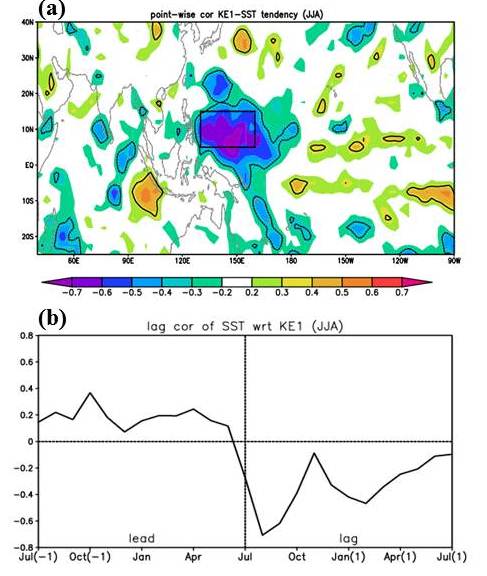State Key Laboratory of Numerical Modeling for Atmospheric Sciences and
Geophysical Fluid Dynamics (LASG)
Institute of Atmospheric Physics, Chinese Academy of Sciences

Vol. 2/No.2 April 2017
[Climate Dynamics]Upscale Feedback of Summer Intraseasonal Oscillations on Seasonal Mean SST in the Tropical Western North Pacific
The ISO-induced surface latent heat fluxes accumulate in boreal summer and constitute a large part of total heat flux anomalies.The ISO-induced surface heat flux may contribute largely to seasonal mean SST change.
Summary: The air-sea interaction over the western Pacific warm pool region is a topic of great importance for understanding the climate variability over Asia and Pacific regions. Regarding the connection among different time scales, previous studies are mainly focused on the downscale effect – the modulation of longer time scale change (as background) on shorter time scale variability. Can the shorter time scale changes feedback to longer time scale state?
Recently, Prof. Renguang WU illustrated a large contribution of ISO-induced surface latent heat flux change to boreal summer seasonal mean SST anomaly in the tropical western North Pacific.An analysis of local correlation reveals a significant negative correlation of the 10-20-day ISO intensity and the seasonal mean SST tendency in the tropical western North Pacific during boreal summer (Fig. 1), suggesting a plausible feedback of the ISO intensity on seasonal mean SST anomaly. Latent heat flux anomalies are separated into components on different time scales using a novel method based on a physical consideration. Due to the nonlinear dependence of latent heat flux on wind speed, the ISO-induced latent heat flux anomalies may accumulate in a season.These ISO-related surface flux anomalies may overcome seasonal mean wind-related latent heat flux anomalies (Fig. 2). Thus, the ISO-induced latent heat flux change may play an important role in the seasonal mean SST change in the tropical western North Pacific.

Figure 1 (a) The point-wise simultaneous correlation of the June-July-August (JJA) mean 10-20-day ISO intensity (KE1) (measured using 850 hPa kinetic energy) and SST tendency (the difference of SST in the succeeding minus preceding month) for the period 1982-2014. The thick lines denote regions where the correlation is significant at the 95% confidence according to the Student t test. The box denotes the region for area averaging of the 10-20-day ISO intensity.(b) Lead-lag correlation of area-mean monthly mean SST with respect toarea-mean 10-20-day ISO intensity (KE1) averaged in the region of 5º-15ºN and130º-160ºE (the box in (a) ) in JJA.

Figure 2 Simultaneous regression with respect to normalized JJA 10-20-day ISO intensity (KE1) in the region of 5º-15ºN and 130º-160ºE (the box) for the period 1982-2014. (a) SST tendency converted to the unit of heat flux using a mixed-layer depth of 45 m, (b) latent heat flux, (c) 850 hPa wind (m/s, scale at the top-right), (d)interannual component of latent heat flux, (e) high-frequency (<90-day) component of latent heat flux, and (f) 10-20-day component of latent heat flux. The contour interval is 3 W/m2. The zero contours have been suppressed. Shading denotes that the anomalies are significant at the 95% confidence level according to the Student t test.
Citation: Wu, R., 2017: Feedback of 10-20-day intraseasonal oscillations on seasonal mean SST in the tropical western North Pacific during boreal spring through fall. Climate Dynamics, doi:10.1007/s00382-016-3362-6.
Web: https://link.springer.com/article/10.1007%2Fs00382-016-3362-6
E-mail: renguang@mail.iap.ac.cn
E-mail: lasg_newsletter@lasg.iap.ac.cn
Editors: Chuanyi Wang (wangcy@lasg.iap.ac.cn), Kangjun Chen(ckj@lasg.iap.ac.cn)